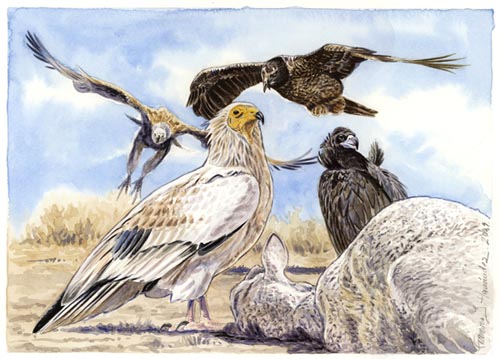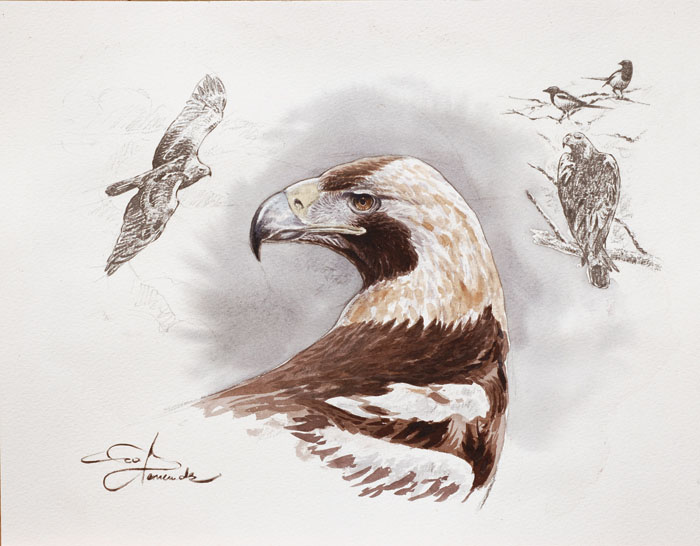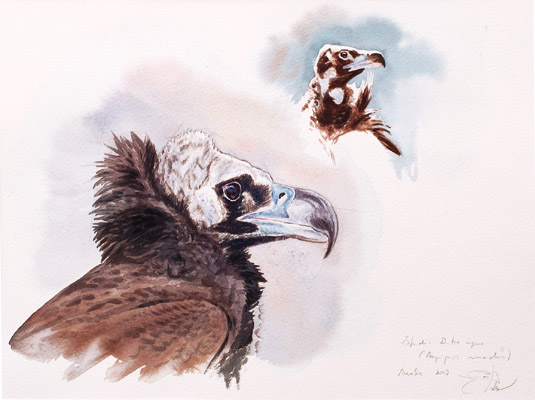

BIRDS OF PREY
Birds of prey are fascinating birds. The beauty of each species, deep eyes, elegance of the silhouette, and for some of them, impressive size, make these birds the kings of the sky!
These raptors kill for feeding. Except the vultures which usually feed on carcasses and carrion, all the birds of prey, from the smallest to the largest, hunt and kill different types of living animals.
They use different ways for hunting. They may hunt from exposed perch, or fly over open areas in order to detect preys, and then, they dive and catch them. But some of them also hunt by walking, searching for large insects or reptiles. Other species fly low from the ground and pursue small mammals, or capture preys such as birds while flying.
Some raptors’ species feed on fish, and hunt while flying low over the water surface, catching the fish with the talons.


RECAPITULATION
DIURNAL RAPTORS
ORDER ACCIPITRIFORMES
Family Accipitridae - Description
Related articles:
The Spanish Imperial Eagle, Spanish mountain's symbol
Eurasian Griffon Vulture's reproduction
Black Kite juvenile : first experiences
Eurasian Sparrowhawk hunting behaviour
Family Accipitridae - List groups
List of the ten groups making this family:
1- Kites, Cuckoo-hawks, Honey-buzzards
2- Fish-eagles - Feeding behaviour
4- Snake-Eagles, Serpent-Eagles and Bateleur
5- Harrier-hawks - Harriers - Crane Hawk
6- Goshawks, Sparrowhawks, Hawks
7- Buzzards – Hawks – Buzzard-Eagle – Solitary Eagles
10- Booted eagles
Family Pandionidae
Osprey – Pandion Haliaetus – Balbuzard pêcheur
Family Sagittariidae
Secretarybird – Sagittarius serpentarius – Messager sagittaire
Family Cathartidae
Related articles:
Andean Condor social behaviour
ORDER FALCONIFORMES
Related article:
NOCTURNAL OWLS
ORDER STRIGIFORMES
Related articles:
Burrowing Owl's breeding behaviour
Francisco José Hernández
Blog illustrations
They often nest in colonies, as on cliff ledges or at treetops, according to the species. Some colonies may gather several tens of pairs on the same cliff.
Most of them are sedentary, but some species, such as the Egyptian Vulture, migrate southwards in winter.
They may perform some displays, but less spectacular than in eagles or falcons, due to their large size. The mates fly together, close to each other, and the pair-bonds last for the life.
Birds of prey are often persecuted by humans, or disturbed during the reproduction. They suffer collisions with electric wires, direct or indirect poisoning, and habitat loss in several parts of the world.
Numerous measures protect them today, as their habitat. They live in natural parks and reserves, where food sources and active protection help them to increase their populations.
New World vultures are classified in the Accipitriforme Order, Cathartidae Family. Old World vultures and different birds of prey such as eagles, buzzards, kites, hawks, harriers … are now in the Accipitridae Family , in the Accipitriforme Order.
Pandionidae has only one member which is the Osprey, like Sagittariidae with the Secretarybird. They belong to the Accipitriforme Order.
Falconidae Family includes falcons and caracaras, in the Falconiforme Order.
I invite you to discover some species by the way of the ID’s cards illustrated by several pictures.
Text by Nicole Bouglouan
Artworks by: Francisco José Hernández
His website: AVESTRAZOS